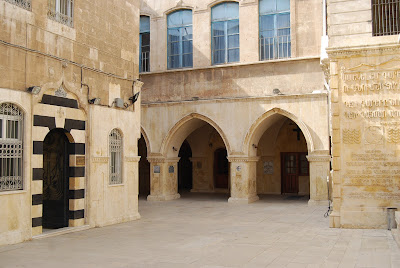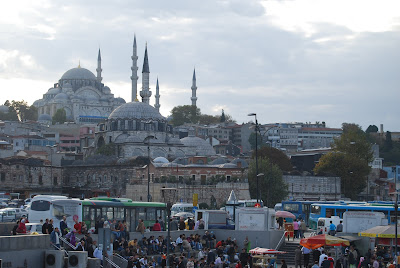 The Omayyad Mosque. Dream come true!
The Omayyad Mosque. Dream come true! Exquisite mosaic work. The Omayyads have employed Byzantine craftsmen in many of their buildings.
Exquisite mosaic work. The Omayyads have employed Byzantine craftsmen in many of their buildings. Depictions of heavenly gardens.
Depictions of heavenly gardens. Inside the mosque - tomb of John the Baptist (Prophet Yahya)
Inside the mosque - tomb of John the Baptist (Prophet Yahya) A typical Damascene courtyard house.
A typical Damascene courtyard house. Sayyida Ruayah Mosque's architecture has the extravagance typically found in most traditional Persian shrines.
Sayyida Ruayah Mosque's architecture has the extravagance typically found in most traditional Persian shrines. The tomb of Sayyida Ruqayah.
The tomb of Sayyida Ruqayah. The man sitting on the chair recited a poem which sparked mourning cries around him.
The man sitting on the chair recited a poem which sparked mourning cries around him. The Damascene stripes.
The Damascene stripes. The taxi drivers, usually evil creatures.
The taxi drivers, usually evil creatures. The Christian Quarter in the Old City.
The Christian Quarter in the Old City. One of the many restored villas, now a tourist restaurant.
One of the many restored villas, now a tourist restaurant. Peanuts of all sorts!
Peanuts of all sorts! The gate to the Temple of Jupiter, now the Omayyad Mosque.
The gate to the Temple of Jupiter, now the Omayyad Mosque. Souq Hamidiyya. Built by the Turks, shelled by the evil French (holes on the roof).
Souq Hamidiyya. Built by the Turks, shelled by the evil French (holes on the roof). Poetry night! I want to learn Arabic now.
Poetry night! I want to learn Arabic now. Me and my favourite building in Syria.
Me and my favourite building in Syria.Damascus however was not an easy place to dislike. Even with this mild dash of hostility, the city is packed with icons of history. This is after all one of the oldest continuously inhabited city in the world. My Lonely Planet sums it up with a beautiful description by Mark Twain:
"Damascus has seen all that has ever occurred on earth,
and still she lives.
She has looked upon the dry bones of a thousand empires,
and will see the tombs of a thousand more
before she dies.
...Damascus measures time not by days
and months and years,
but by the empires she has seen rise
and prosper
and crumble to ruin.
She is a type of immortality."
The souqs here are bigger than the ones in Aleppo and with the influx of Iranian pilgrims, it was much more lively. My first day in Damascus was just about the souqs- I just walked for hours absorbing the energy and scents so that I will remember it. The Lonely Planet map for the Old City was so bad as well so that helped me to wander off from the main thoroughfares and into the more secluded parts. If it wasn't because I carried a backpack, I would've bought a great many things from the souqs - Arabic lanterns, frankincense, divan stools, carpets, backgammon set. The craftmanship is excellent here and where there aren't that many tourists, you can get handmade carpets as cheap as 15 Euros! My haggling skills are now honed from previous travels and the Syrians are much easier to negotiate with than Moroccans or the Chinese.
The Omayyad Mosque was my favourite place in Damascus. Like Hagia Sophia, it's one of those buildings that I've read so much about and seeing it for myself was unreal. I went early in the morning where the Iranian pilgims have already started to converge and the Byzantine mosaics shined its best. There are so many pre-Islamic elements in the mosque (remnants of Temple of Jupiter, Byzantine craftmanship, almost basilical in form) it certainly doesn't look like the kind of mosques that I'm used to.
The tomb of Hussein is located in the mosque courtyard making it one of the most important pilgrimage sites for Shia Muslims. I've never been to a Shia mosque before so it was certainly an experience for me. Some of the Iranians (who were in a more sober mood at the time) were amused to see me bewildered and enchanted by the collective chants and the heartfelt wailing of their faithful. It was the same when I visited the Sayyida Ruqayah Mosque just few streets away. This time it was almost exclusively Iranian. The power of the mourning overwhelmed me. It was hard not to be moved by their sadness. Inside there was a man who recited a poem and he did it beautifully. Everyone around him knelt and cried with all their heart. There was such melancholy. It is interesting that the memory of the Massacre, that happened few centuries back, was preserved with such immediacy. Everyone cried like it happened yesterday. After a while I decided I need to get back with the living. I left the mosque feeling depressed so I went back into the maze of souqs to lift my spirits back up.
Damascus is such a great place to study architecture. On my third day, I did a tour of the palaces and villas of the old Damascene upper class. These houses were not just a testament of the kind of wealth the city once had but also the craftsmanship of the masons. I especially loved how they create patterns on the facade using coloured stones inlaid into the stone work. It seemed like everything was so interconnected they must've had an integrated plan for all aspect of the building. Or maybe it was just a tradition that was refined by centuries of trial and error.
But Damascus is not complacent with its place in history. The arts scene is lively. I never had much time to explore more of this side of modern Damascus but I did go to one poetry recital night. It was my first full-on encounter with modern Syria. Unlike the case in most places, it wasn't an exclusively middle-class affair. That night, taxi drivers, women in tank tops or with full hijabs, communists, stalinists, old men, young people rubbed shoulders in that cramped underground bar. I truly regret not learning Arabic. Poetry is a potent medium in this part of the world. With stinging political commentaries, atmosphere was great that night. I felt a certain tension as well knowing full well that this place could get raided anytime!


































